
Adolescents' Use of the World-Wide Web in Ten Public Schools
A Uses and Gratifications Approach
Seiten
2008
VDM Verlag Dr. Müller
978-3-639-09603-3 (ISBN)
VDM Verlag Dr. Müller
978-3-639-09603-3 (ISBN)
- Titel nicht im Sortiment
- Artikel merken
Public school students'' attitudes and opinions toward
the World-Wide Web were analyzed to discover if and
how they affect students'' use of this new educational
medium in a school setting. An exploratory principle
components analysis of forty use statements resulted
in an eight-factor solution. Cross-tabular analyses
revealed significant differences in the way that
students describe their use of the WWW. Gender, grade
level, and amount of time spent using the WWW were
used to create between-group comparisons in the seven
WWW use categories that made up the
computer-administered survey instrument. The final
phase of data analysis was a content analysis of
sites visited by students. The commercial sites
received the lowest rating for "suitability for
academic research" of all the domain names. And while
students reported their purpose for using the WWW as
"research and learning" fifty-two percent of the
time, the coders found only twenty-seven percent of
the sampled sites to be "suitable" for that purpose. Public school students' attitudes and opinions toward
the World-Wide Web were analyzed to discover if and
how they affect students' use of this new educational
medium in a school setting. An exploratory principle
components analysis of forty use statements resulted
in an eight-factor solution. Cross-tabular analyses
revealed significant differences in the way that
students describe their use of the WWW. Gender, grade
level, and amount of time spent using the WWW were
used to create between-group comparisons in the seven
WWW use categories that made up the
computer-administered survey instrument. The final
phase of data analysis was a content analysis of
sites visited by students. The commercial sites
received the lowest rating for "suitability for
academic research" of all the domain names. And while
students reported their purpose for using the WWW as
"research and learning" fifty-two percent of the
time, the coders found only twenty-seven percent of
the sampled sites to be "suitable" for that purpose.
the World-Wide Web were analyzed to discover if and
how they affect students'' use of this new educational
medium in a school setting. An exploratory principle
components analysis of forty use statements resulted
in an eight-factor solution. Cross-tabular analyses
revealed significant differences in the way that
students describe their use of the WWW. Gender, grade
level, and amount of time spent using the WWW were
used to create between-group comparisons in the seven
WWW use categories that made up the
computer-administered survey instrument. The final
phase of data analysis was a content analysis of
sites visited by students. The commercial sites
received the lowest rating for "suitability for
academic research" of all the domain names. And while
students reported their purpose for using the WWW as
"research and learning" fifty-two percent of the
time, the coders found only twenty-seven percent of
the sampled sites to be "suitable" for that purpose. Public school students' attitudes and opinions toward
the World-Wide Web were analyzed to discover if and
how they affect students' use of this new educational
medium in a school setting. An exploratory principle
components analysis of forty use statements resulted
in an eight-factor solution. Cross-tabular analyses
revealed significant differences in the way that
students describe their use of the WWW. Gender, grade
level, and amount of time spent using the WWW were
used to create between-group comparisons in the seven
WWW use categories that made up the
computer-administered survey instrument. The final
phase of data analysis was a content analysis of
sites visited by students. The commercial sites
received the lowest rating for "suitability for
academic research" of all the domain names. And while
students reported their purpose for using the WWW as
"research and learning" fifty-two percent of the
time, the coders found only twenty-seven percent of
the sampled sites to be "suitable" for that purpose.
Samuel Ebersole received his BA from Southern California College
and his MA and PhD from Regent University. Since 2000 he has been
a NATPE Faculty Fellow, an International Radio & Television
Society Fellow, a Berglund Center for Internet Studies Fellow,
and a recipient of the Stephen H. Coltrin Award for Excellence in
Communications Education.
| Sprache | englisch |
|---|---|
| Themenwelt | Sozialwissenschaften ► Kommunikation / Medien ► Allgemeines / Lexika |
| Sozialwissenschaften ► Kommunikation / Medien ► Medienwissenschaft | |
| Schlagworte | Internet |
| ISBN-10 | 3-639-09603-7 / 3639096037 |
| ISBN-13 | 978-3-639-09603-3 / 9783639096033 |
| Zustand | Neuware |
| Haben Sie eine Frage zum Produkt? |
Mehr entdecken
aus dem Bereich
aus dem Bereich
Falzen, Heften, Binden für Gestalter
Buch | Hardcover (2023)
Verlag Hermann Schmidt
CHF 76,95
Das offizielle Adressbuch der Stadt Tübingen
Buch (2023)
Ungeheuer + Ulmer (Verlag)
CHF 39,95
Das offizielle Adressbuch der Stadt Freiberg
Buch (2023)
Ungeheuer + Ulmer (Verlag)
CHF 20,85


